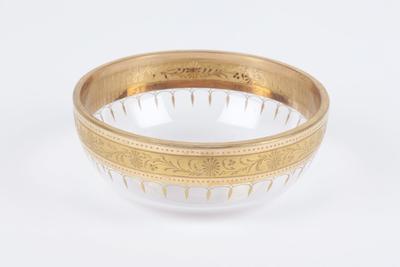Finger bowl
Maker & role
Unknown, Maker
Production date
circa 1860
See full details
Object detail
Collection
Measurements
0 - Whole, H: 4.5 x W: 15.8cm (H: 45 x W: 158mm)
Production notes
English or French.
Blown glass (?), gilded and hand painted
Blown glass (?), gilded and hand painted
Signature & marks
None
Credit line
Purchase, 2007
Vaucluse House Collection, Museums of History New South Wales
Vaucluse House Collection, Museums of History New South Wales
Caption
Clear glass finger bowl, circa 1860
Description
Clear glass finger bowl, with applied gilt pattern below the rim in the form of a delicate, lace-like ‘gothic cornice’, and central gilt patera within the bowl.
Vaucluse House is furnished to reflect its occupancy by William Charles Wentworth and his family during the period 1827-53 and 1861-62, with preference is given to Wentworth provenanced items. The collection is particularly rich in table ware, and the dining room is typically set to reflect aspects of early to mid19th century dining, with visitors able to follow the entire progress of foodstuffs from the garden to the kitchens, butler’s pantry and table. Though not part of a set, this bowl will be used in food and dining related programmes, and has the potential for use in design and applied arts related activities and displays.
Finger bowls were used in British dining between the main and dessert courses. The bowl reflects Wentworth’s preference for the Gothic Revival, seen in Vaucluse House’s facades, entrance hall, drawing room cornice and dining room sideboards. The style was made fashionable by the building of New Government House in 1836-1845 and was probably adopted by Wentworth, following the lead of Sir Thomas Mitchell, to suggest his noble descent (he was related to the Wentworths of Wentworth Woodhouse in Yorkshire, England) over his more recent connections tainted by convictism and illegitimacy.
The ‘gothic cornice’ motif, created a by a series of overlapping arches whose intersections form pointed arches and where the lowermost points are embellished into pendant forms, was originally a feature of 18th century ‘Gothick’ interiors (often termed ‘Strawberry Hill Gothic’ after Horace Walpole’s influential villa), was developed from the highly ornate arcade forms seen in Venetian Gothic architecture. It is often seen in plasterwork and stucco as a cornice and in cabinetwork. Its use here is typical of the historical revivalism that dominated design in the mid 19th-century, particularly, the revival of Venetian Gothic following the publication of John Ruskin’s ‘The Stones of Venice’ (London, 1851-53).
Vaucluse House is furnished to reflect its occupancy by William Charles Wentworth and his family during the period 1827-53 and 1861-62, with preference is given to Wentworth provenanced items. The collection is particularly rich in table ware, and the dining room is typically set to reflect aspects of early to mid19th century dining, with visitors able to follow the entire progress of foodstuffs from the garden to the kitchens, butler’s pantry and table. Though not part of a set, this bowl will be used in food and dining related programmes, and has the potential for use in design and applied arts related activities and displays.
Finger bowls were used in British dining between the main and dessert courses. The bowl reflects Wentworth’s preference for the Gothic Revival, seen in Vaucluse House’s facades, entrance hall, drawing room cornice and dining room sideboards. The style was made fashionable by the building of New Government House in 1836-1845 and was probably adopted by Wentworth, following the lead of Sir Thomas Mitchell, to suggest his noble descent (he was related to the Wentworths of Wentworth Woodhouse in Yorkshire, England) over his more recent connections tainted by convictism and illegitimacy.
The ‘gothic cornice’ motif, created a by a series of overlapping arches whose intersections form pointed arches and where the lowermost points are embellished into pendant forms, was originally a feature of 18th century ‘Gothick’ interiors (often termed ‘Strawberry Hill Gothic’ after Horace Walpole’s influential villa), was developed from the highly ornate arcade forms seen in Venetian Gothic architecture. It is often seen in plasterwork and stucco as a cornice and in cabinetwork. Its use here is typical of the historical revivalism that dominated design in the mid 19th-century, particularly, the revival of Venetian Gothic following the publication of John Ruskin’s ‘The Stones of Venice’ (London, 1851-53).
Accession number
V2007/25



Public comments
Be the first to comment on this object record.